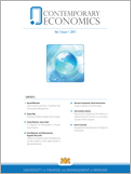Determinants of Banking Efficiency for Commercial Banks in Indonesia
Determinants of Banking Efficiency for Commercial Banks in Indonesia
Author(s): Heti Suryani Fitri Sulaeman, Sri Mulyantini Moelyono, Jubaedah NawirSubject(s): Economic development, Financial Markets, Public Finances, Fiscal Politics / Budgeting
Published by: Akademia Ekonomiczno-Humanistyczna w Warszawie
Keywords: Bank efficiency; Data Envelopment Analysis (DEA); Commercial Banks;
Summary/Abstract: This study analyzes internal and external factors that affect banking efficiency by using quarterly data for 2013-2017. The sample includes conventional and Islamic commercial banks. Hypothesis testing uses the Tobit regression model. The results show that the loan to deposit ratio/ financing to deposit ratio (LDR/FDR), the net interest margin/net operating margin (NIM/NOM), the capital adequacy ratio (CAR), and economic growth have a significantly positive effect on the efficiency of commercial banks. The NIM/NOM, the BI-rate, and the inflation have no effect on the efficiency of commercial banks. According to another analysis, factors that influence the efficiency of the results show that in conventional commercial banks, the LDR, the CAR, economic growth, and inflation have a significantly positive effect on the efficiency of conventional commercial banks. In contrast, the NIM has a significantly negative effect. Meanwhile, for Sharia commercial banks, the FDR, NPF, the CAR, economic growth and inflation have a significantly positive effect, and the BI-rate has a significantly negative effect.
Journal: Contemporary Economics
- Issue Year: 13/2019
- Issue No: 2
- Page Range: 205-218
- Page Count: 14
- Language: English

